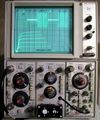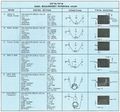5CT1N
Jump to navigation
Jump to search
The Tektronix 5CT1N is a curve tracer plug-in for the 5000 series oscilloscopes, similar to the 7CT1N for 7000-series scopes. The 5CT1N was designed by Matt Zimmerman.
Key Specifications
| DUT drive voltage (C-E) |
|
|---|---|
| DUT current display |
|
| Base/Gate drive |
|
| DUT connection | Three 4 mm jacks / binding posts |
| DUT adapters |
|
Links
Documents Referencing 5CT1N
| Document | Class | Title | Authors | Year | Links |
|---|---|---|---|---|---|
| Tekscope 1971 V3 N5 Sep 1971.pdf | Article | New Products | 1971 | 7L12 • 7CT1N • 5103N • 5A13N • 5A14N • 5A22N • 5CT1N • 172 • 1501 • P6056 • P6057 • 603 • 604 • 4602 • S-3160 | |
| Tekscope 1972 V4 N6 Nov 1972.pdf | Article | Oscilloscope to Curve Tracer with One Plug-in | Matt Zimmerman | 1972 | 5CT1N • 7CT1N |
| 48W-3346-3.pdf | Brochure | Making the Correct Semiconductor Measurements Time After Time | 1982 | 576 • 172 • 176 • 577 • 178 • 5CT1N • 7CT1N |
Documents Referencing Curve tracers
| Document | Class | Title | Authors | Year | Links |
|---|---|---|---|---|---|
| 062-1009-00.pdf | Book | Measurement Concepts: Semiconductor Device Measurements | John Mulvey | 1969 | Curve tracers • Tunnel diodes |
| Tekscope 1969 V1 N1 Feb 1969.pdf | Article | Curve Tracing Displays | 1969 | Curve tracers • 576 | |
| Tekscope 1969 V1 N5 Oct 1969.pdf | Article | Troubleshooting the Sweep Ciruits | Charles Phillips | 1969 | 575 • 576 • Curve tracers |
| Tekscope 1972 V4 N3 May 1972.pdf | Article | Semiautomatic Testing with the Curve Tracer | Jack Millay | 1972 | 576 • 172 • Curve tracers |
| Tektronix Curve Tracers - Device Testing Techniques.pdf | Book | Tektronix Curve Tracers - Device Testing Techniques | 1985 | Curve tracers • Tunnel diodes |
Pictures
-
5CT1N in 5440 mainframe vertical bay, X output connected to time base X input
-
Displaying transistor curves
-
-
-
Common Problems
C30 and C32 (100 μF, 25 V) are under-rated and therefore have a tendency to leak or short, causing associated resistors R30 and R32 (240 Ω, 0.25 W, 5%) to overheat and fail. C30 and C32 should be replaced with modern equivalents rated above 35 V.
Components
Some Parts Used in the 5CT1N
| Part | Part Number(s) | Class | Description | Used in |
|---|---|---|---|---|
| 2N3958 | 151-1054-00 • 151-1054-01 • 151-1054-02 | Discrete component | dual n-channel JFET | FG503 • MR501 • M3 • PG505 • SC501 • SC502 • SC503 • SG502 • 1450 • 1501 • 1502 • 1503 • 221 • 5A23N • 5CT1N • 577 • 603 • 603A • 604 • 604A • 605 • 606 • 606A • 606B • 607 • 607A • 620 • 624 • 7CT1N • 7D15 • 7D20 • 851 |





